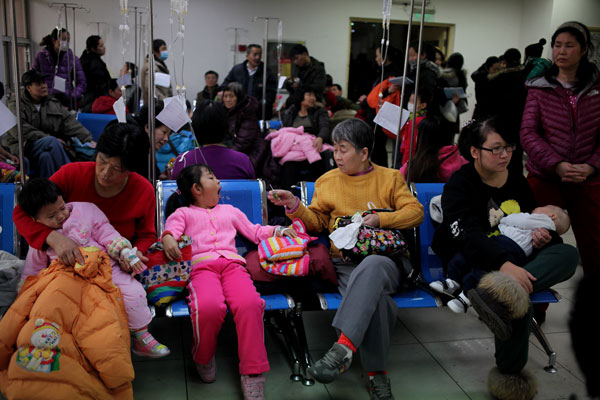Flu awareness comes in from the cold
 |
|
Young patients at the Capital Institute of Pediatrics in Beijing. Children and the elderly are more vulnerable to fl u viruses. WANG JING / CHINA DAILY |
Flu surveillance network
China has 556 flu surveillance stations nationwide, mainly in hospitals. Samples collected at the sites are sent on to labs run by the China CDC and regional branches for final checks.
Under the current network, every week each "sentry" hospital is required to send samples of five to 15 flu-like cases to designated labs, and report related information for further analysis, he explained.
"The key to our surveillance is to detect an emerging epidemic trend and potential viral mutations in good time, to issue health warnings and to help the decision makers prepare the appropriate response," said Wang Quanyi, director of the infectious disease institution of the Beijing CDC.
In Beijing, the local authorities began sending health-related text messages to mobile phone users, focusing on flu prevention tips.
Most of the cases have been mild and patients recover fully in around two weeks, according to experts. But for children, the elderly and those suffering from chronic diseases, the illness can lead to serious complications or even death.
"We should be on high alert, particularly in the face of new trends", stressed He.
In 2009, an outbreak of H1N1, a little known strain at the time, led to around 18,000 deaths globally, according to the World Health Organization.
Low awareness
Public awareness of flu has risen in tandem with the improvement in surveillance capability that followed the SARS outbreak of 2003, said Wang.
However, he conceded that understanding of the illness remains relatively limited, even among medical professionals.
A study conducted by the China CDC in 2012 discovered that seasonal flu was responsible for more deaths in the country than had previously been thought. The study, based on data from eight cities with especially accurate mortality figures, showed that between 2003 and 2008, a large number of deaths that had originally been attributed to respiratory and circulatory failures were actually caused by flu and that in 86 percent of cases, the victims were aged 65 and older.
Also, unlike the United States where the H3N2 virus caused most flu-related deaths, the Influenza B virus led to most of the deaths on the Chinese mainland, according to the report.
Worryingly, most people in China mistook cases of flu for common colds, said He. That may be caused, in part, by a linguistic quirk, he said: In Mandarin flu is called liugan, which means "infectious cold" and is derived from the word for common cold. However, unlike the common cold, flu tends to produce more intense symptoms and much more serious complications or even death, according to He.
"That's the reason why we have to pay special attention to viral infections and carry out interventions to avert any extra deaths caused by a flu epidemic," he said.
Demand for inpatient care, particularly among the elderly and those with underlying chronic conditions, usually increases substantially in flu season, further straining limited medical resources and other related sectors, according to He.
An epidemic can take an economic toll through lost or reduced productivity, and also strain medical and related services, he warned.
Ma Anlin, deputy director of the department of infectious diseases at the China-Japan Friendship Hospital in Beijing, said the hospital's fever clinic is receiving an average of around 300 people a day, many more than earlier in the winter.

























